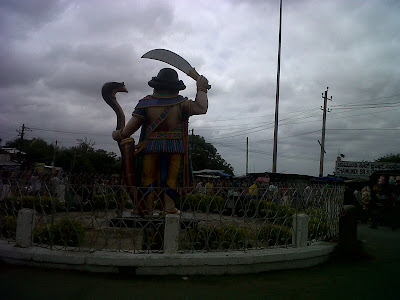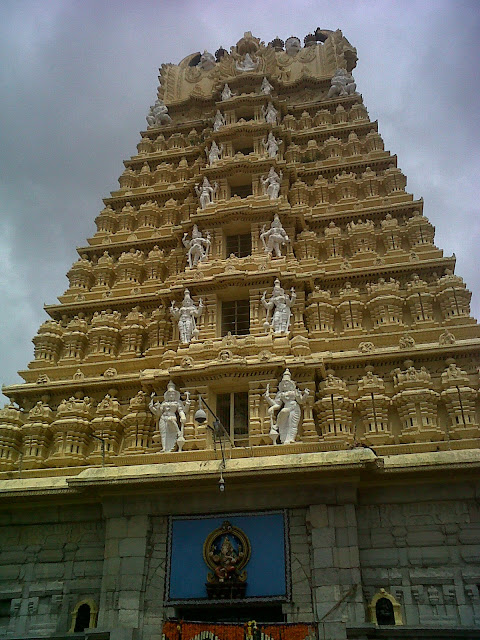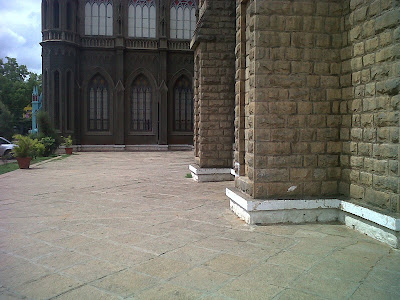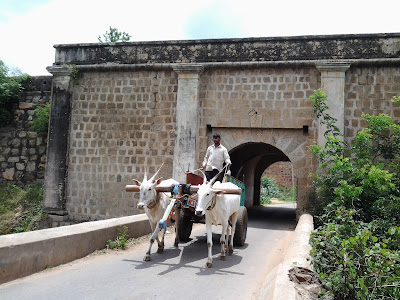Mysore is located approx 150 kms from Bangalore at the
base of Chamundi Hills. Its elevation is 770 meters from sea level & it is
spread over 130 sq kms. Population of Mysore is less than ten lacs. Weather is hot
& humid & best time to visit is Oct –Mar.
 |
| Mysore Palace |
Bangalore-Mysore road is a good four lane road and coconut trees, lush green fields & hills on either side make it a lovely drive. Eateries & resorts line up the road. Spoilers are large hoardings on either side of the road. And to keep you safe they decided to put speed breakers after every few kilometers If it is not a speed breaker it is a cut for u-turn, or a barricade or a red light or a cow. And they have ‘designer breakers’ -a large hump, or set of two small-humps or a set of five / seven smaller humps! So take it easy with accelerator. Train connection is also available.
 |
| At the Palace gate |
 |
| Lush green & beautiful |
 |
| Rain clouds gather over the Palace |
 |
Palace was built in 1897 - 1912 by an English Architect
Mysore was the capital of Kingdom of Mysore ruled by Wadiyar’s (Odiyar’s in Kannada) from 1399 till 1947 when it was merged in India. For a brief period it was taken over by Haider Ali & then by his son Tipu who was killed by British in 1799. Thereafter British handed over a truncated kingdom of Mysore as princely state back to Wadiyar’s. It was Krishnaraja Wadiyar IV who put the city on world map by planning & beautifying Mysore.
|
 |
| It was built to replace a wooden palace destroyed in fire |
 |
| Front Elevation |
 |
| It also houses a residential quarters |
 |
| One of the several temples inside the Palace |
 |
| Grand & graceful |
 |
| Beautiful |
 |
| Mysore City's Signature |
 |
| Front lawns |
 |
| Crouching tigers |
Name of the town is derived from Mahishasurana Ooru – town of Mahisha the Asura. A mythological legend has it that Mysore area was once ruled by a powerful but cruel demon king Mahisha Asura. Mahisha could assume the form of buffalo (mahisha) as well. He was powerful, cruel & became invincible out to wreck the world. Prayers of devtas for deliverance from this demon were heard by goddess Parvati & she took birth as Chamunda. After a fierce fight for ten days the demon Mahisha was slain by her on the hill top. The hill has thus been named Chamundi Hill & the Goddess been named Mahishasur Mardini or Chamundeshwari.
Chamundeshwari temple is situated atop Chamundi Hills. Another
historical version is that Cha was Goddess of Munda tribals to whom the
offerings were made of animals, humans & liquor. Slowly Mundas merged into
Hindus & the sacrifices ended & the name Chamunda persisted. Initially
temple was small one & sacrifices were also offered but were stopped in
eighteenth century. It could be reached by road these days or by way of climbing 1000 steps.
Temple is over a thousand year old. Various kings have
contributed to it over the years & it has grown into a magnificent & a busy
temple.
 |
| Mahishasur |
 |
| Welcome to Chamundi Hills says Mahishasur |
 |
| Essentials for pooja are available here |
 |
| This clutter of barricades spoil the beauty & the serenity of the temple. There are three lines for Darshan - free, Rs.30/ & Rs.100/. Even with Rs.100/ tickets in hand it took one hour to reach inside. Inside it is stuffy due to burning of agarbattis, lamps & crowd. One fleeting darshan & guards push you out. If you want to stay longer pay bakshish! |
 |
| Idol being taken to temple |
 |
| Front elevation |
 |
| Here the coconuts are being smashed & broken by the people on right. People on left a boy, lady & the fellow in saffron picks them up. White bag is getting filled up of broken coconuts. |
 |
| Flowers, molly thread, kumkum, fruits, agarbatti are being sold. Everyone of them mostly ladies, shouts for your attention. |
 |
| Beauty of the right side of temple is spoiled by tin roofs & iron structures. |
 |
| They are specialist in threads. Looks like a customer has been lost to a competitor |
 |
| Lord Ganesha presides over the entrance |
 |
| Just outside of sanctum-sanctorum. You can have Charnamrit & Tilak here |
 |
| View of Mysore from Chamundi Hill |
 |
Another view of Mysore on left foreground is the Chamundi Hill
|
St Philomena’s Church is situated in the middle of the
town & has a imposing & magnificent look with lofty towers. The Maharaja
of Mysore laid the foundation of the church on 28.10.1933. The church was
designed by a Frenchman & its architecture was inspired by Cologne
Cathedral, Germany. On the backside we were shown a tunnel reported to be
linked to the palace which has since been closed.
 |
| Imposing towers of St Philomena's Church |
 |
| Twin spires are 175 feet high |
 |
| Front Doors |
 |
| Side view |
 |
| Imposing & majestic towers |
 |
| Side view |
 |
| Mosque made by Maharja |
 |
| Clock Tower |
Srirangapattan
Tipu Sultan eldest son of
Haider Ali ruled Mysore kingdom from 1782 to 1799. He was a soldier & a
scholar. He knew French, English & promoted Hindustani in administration.
He introduced new coins, new calendar & new land revenue system. Both Haider
& Tipu had their capital in Srirangapatana approx 15 kms from Mysore. He had sent diplomatic missions
to France, Oman, Afghanistan & Istanbul. He used French army officers to
train his army. He fought four wars & in fourth, was killed in his fort at
Srirangapatan betrayed by his friend & confidant. After his death his
palace Rang Mahal & Lal Mahal within the walls of Srirangapatana fort were looted & completely destroyed. His
treasure of gold, cash, family jewelry his clothes, shoes, firearms, swords & other valuable artifacts were shipped to England.
 |
| Here Tipu was shown to his enemies while he came for a bath. Cauvery flows nearby from where water is available here. Archaeological Survey of India has lot of work to do here. |
 |
| One of the 15 armouries in the fort |
 |
| Present day scene inside the Srirangapattana fort! Age old cart - only change is the tyres. Just beneath the bullock cart there ran a moat 30 feet across having crocodiles. Presently it is dry & is home to shrubs, bushes, snakes & other lizards. |
 |
| Madrasa building in the fort. Said to have been a temple. On top of Minars there are Kalashas & on two corners of the building on the roadside there are figures of Vishnu & cobra Nag. |
 |
| One of the armouries |
 |
| One of the 24 watch towers of the fort. This one has been refurbished as flag hoisting stage |
 |
| Delhi Gate. Small chambers are meant for guards. |
 |
| Colonel Bailey's Dungeon. Here English Army officers were kept prisoners. They were chained to stone pegs in the wall. Several of them died here including Col Bailey. |
 |
| Entrance to the Dungeon. It is almost four floors down. |
 |
| Back of the mausoleum - Gumbaz |
 |
| Entrance of the mausaleum - Gumbaz |
 |
| Haider Ali, Fatima & Tipu lie buried in this Gumbaz |
 |
| Gumbaz & flag of Tipu. Inside the mausoleum walls & ceiling have have been done like stripes & skin of a tiger. |

















































No comments:
Post a Comment